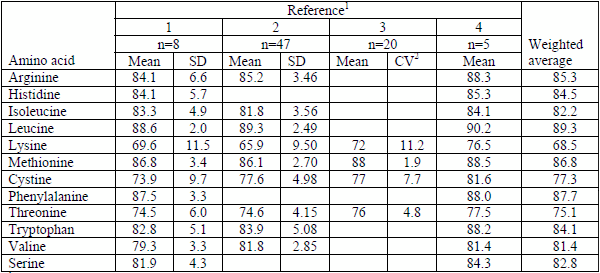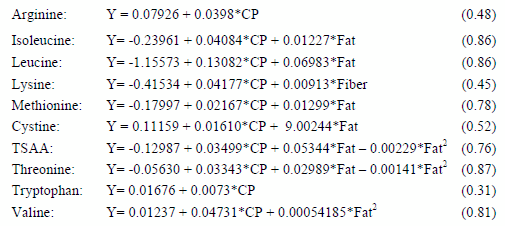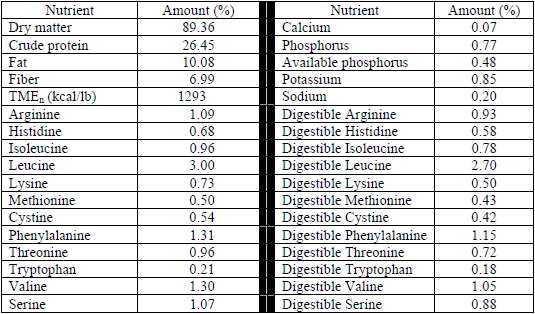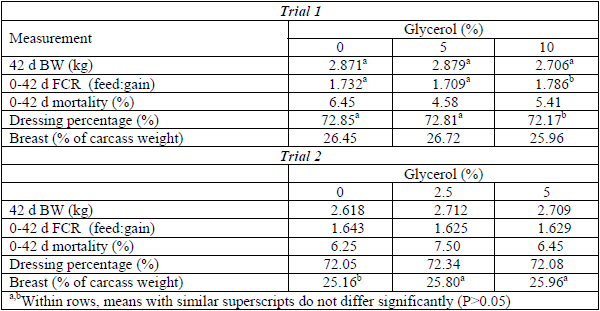Introduction
Distillers Dried Grains With Solubles
Byproducts of the distilling industry such as distillers dried grains and distillers dried grains with solubles (DDGS) have long been commonly accepted feed ingredients in broiler diets. Early studies have been extensively reviewed by Scott (1965, 1970). Due to their supply and price, these products were typically fed at levels not exceeding 5% of the diet. However, early studies demonstrated that higher levels could be used in nutritionally balanced diets. Runnels (1966; 1968) reported that 20% DDGS was successfully incorporated into broiler diets with performance equal or superior to that of chicks fed diets with corn, soybean meal, and fish meal. Waldroup et al. (1981) reported that when DDGS was included into broiler diets with the ME content held constant, up to 25% DDGS could be used without reduction in body weight or feed utilization. When included in diets in which the energy content was allowed to decline as the level of DDGS was increased, there was a decline in performance at DDGS levels of 15% or more. Potter (1966) found that isonitrogenous diets with 20% DDGS supported performance equivalent to control diets when fed to poults up to 8 wk of age. Couch et al. (1970) reported that up to 37% DDGS could be used in diets for broiler breeder replacements. Jensen (1978) reported that 20% DDGS was acceptable in nutritionally balanced layer diets and contributed a factor that improved Haugh Units of eggs. Jensen (1981) stated that 20% DDGS could be used in diets for broiler breeder hens.
If the “modern” DDGS from fuel ethanol production is equal or superior in nutritional value to the “old” DDGS, it is reasonable to expect that satisfactory performance can be obtained when reasonable levels are included in nutritionally-adequate diets. Lumpkins et al. (2004) indicated that DDGS from modern ethanol plants can be safely used at 6% in broiler starter diets and 12 to 15% in grower and finisher periods. Lumpkins et al. (2005) suggested a maximal inclusion rate of 10-12% DDGS in diets for laying hens. Roberson et al. (2005) reported that 15% DDGS did not adversely affect performance of laying hens but suggested that lower levels of DDGS be used when introducing it into the diet. Swiatkiewicz and Korleski (2006) reported that up to 15% DDGS could be used in layer feeds; inclusion of 20% negatively affected laying rate and egg weight. Roberson (2003) noted that DDGS could be effectively included at 10% in growing-finishing diets for turkey hens if proper formulation matrix values for all nutrients were used. Noll and Brannon (2006) reported that performance of turkeys fed 20% DDGS was not different from the corn-soybean control unless used in combination with high levels of poultry byproduct meal (8-12%).
Like any byproduct, several concerns exist regarding the use of DDGS in poultry feed. These relate primarily to the extent of overall nutrient variability. Major concerns include 1) variation in metabolizable energy content; 2) content and bioavailability of lysine; 3) content and bioavailability of phosphorus, and 4) variation in sodium content. In order to properly utilize DDGS, accurate information regarding the nutrient values for the specific product available is essential. While a general knowledge of the average nutrient content of DDGS, in general, is helpful, the extreme variability that has been observed in various studies raises a great deal of concern as higher usage levels are contemplated. These issues are addressed below.
Variable nutrient content
Reliable nutrient values for DDGS are important for optimum use of this product in swine and poultry diets, and recent studies have provided information on various nutrients such as amino acid, metabolizable energy, and mineral contents of DDGS from new ethanol plants (Table 1).
Table 1. Proximate composition and amino acid content of DDGS (%, as fed basis).
 1
1 1=Spiehs et al. (2002); 2=Fiene et al. (2006); 3=Parsons et al. (2006); 4=Fastinger et al. (2006); 5=Batal and Dale (2006).
2Coefficient of variation.
Spiehs et al. (2002) reported almost as much variation within a source as between different plants. Thus, a continual quality control program to characterize the product will be essential if optimum usage is to be made of DDGS in a poultry formula.
Amino acid content and lysine digestibility
Extensive analyses of the amino acid contents of DDGS samples have recently been reported by several investigators (Table 1). Mean values for lysine and methionine, the two most critical amino acids for poultry and swine, were similar, but considerable variability was observed. Fiene et al. (2006) conducted stepwise regression analysis on data from approximately 150 samples to predict total amino acid content from the proximate values of moisture, crude protein, fat, and fiber and reported the following equations and R2 values (in parentheses):
The R2 values suggest that some amino acids (Ile, Leu, Met, TSAA, Thr, and Val) could be predicted with some success from the proximate values. However, others such as Arg, Cys, Lys, and Trp could not be predicted with a high degree of accuracy due largely to a lack of consistency of the amino acid to protein ratio in the samples tested.
Nutritionists are concerned not only with total amino acid content but also the digestibility. Of greatest concern with DDGS is the bioavailability of lysine, as during the process of drying DDGS the material is typically exposed to temperatures of approximately 315º C (600º F). The adverse effect of excess heat on amino acid availability and especially on lysine is well known (McGinnis and Evans, 1947; Warnick and Anderson, 1968). Several recent studies have evaluated the digestibility of amino acids in DDGS and the results are summarized in Table 2.
Table 2. Digestible amino acid coefficients (%) of DDGS.
 1
11=Batal and Dale (2006); 2=Fiene et al. (2006); 3=Parsons et al. (2006); 4=Fastinger et al. (2006)
.
2Coefficient of variation.
The digestibility of lysine is the lowest among the amino acids and also has the greatest variability. A rapid means of assessing the lysine digestibility in a particular sample of DDGS is of prime importance in optimizing the use of this ingredient, and two methods recently have been proposed in this regard. One of these is the use of the Immobilized Digestibility Enzyme Assay (IDEA™, Novus International, St. Louis MO) described by Shasteen et al. (2002). This assay was used to estimate the lysine digestibility of 28 DDGS samples that had previously been subjected to in vivo-determined true lysine digestibility. There was a high correlation between in vivo-determined true lysine digestibility and that estimated by the IDEA™ method (Fiene et al. 2006). The correlation between digestibility of other amino acids and the IDEA™ method was not as successful, ranging from 0.12 for Met to 0.43 for Cys. More than 180 samples of DDGS have been subjected to the IDEA™ assay by Novus International, resulting in an estimated lysine digestibility of 66.7 ± 9.3 (mean ± SD). This is in good agreement with the weighted average of 68.5% shown in Table 2.
In order to evaluate variation among producers, multiple DDGS samples were collected from eight different suppliers over a 3 to 4 month time period and subjected to the IDEA™ assay (Fiene et al., 2006). The data showed that within a supplier the variation in lysine digestibility was relatively small with a few exceptions. It is recommended that the IDEA™ assay be used periodically to estimate the digestible lysine content of samples received in a feed mill, especially since the product may come from a wide variety of sources.
A second method that has been used to estimate lysine digestibility is evaluation of the color of the product. Formation of lysine-carbohydrate complexes under heat has long been known (Maillard, 1912a,b). Color of soybean meal has long been linked to proper processing temperature (McNaughton et al., 1981). Numerous studies have linked the color of DDGS with lysine digestibility (Cromwell et al., 1993; Ergul et al., 2003; Batal and Dale, 2006; Fastinger et al., 2006). Batal and Dale (2006) reported that samples with more lightness (L*=60.3) and more yellowness (b*=25.9) were associated with a DDGS having an average of 0.66% digestible Lys whereas products that were darker (L*=50.4) and less yellow (b*=7.41) were associated with a product having 0.18% digestible Lys. Use of visual color or use of color meters may be used to identify samples of DDGS that have been subjected to excessive heat with subsequent reduction in lysine bioavailability.
Metabolizable energy content of DDGS
Several studies provide estimates of the metabolizable energy content of DDGS. Batal and Dale (2006) reported an average TMEn for 17 samples of 1282 ± 82 kcal/lb, with a range of 1132 to 1450 kcal/lb. Fastinger et al. (2006) found an average of 1302 kcal/lb for five samples with a range of 1127 to 1382 kcal/lb. Lumpkins and Batal (2005) reported a TMEn value of 1318 kcal/lb for a single sample of DDGS. Parsons et al. (2006) reported an average TMEn of 1299 kcal/lb for 20 samples with a range from 1182 to 1385 kcal/lb. A weighted average of these 43 samples is 1293 kcal/lb. Batal and Dale (2006) applied regression analyses to the proximate composition of the DDGS and the determined TMEn values and developed the following equations (R2 values in parentheses), which can be applied to samples of DDGS to estimate the TMEn value:
DDGS mineral content and relative phosphorus bioavailability
Several recent reports on the mineral content of DDGS have been published and are summarized below (Table 3). The bioavailability of the P in DDGS appears to be higher than previously assumed (National Research Council, 1994). This may be in part because of the P provided by the residual yeast, which is considered to be highly available, and because the fermentation may release some P from the phytate bond. As early as 1972, Singsen et al. reported that the biological availability of the phosphorus in three composite samples of DDGS was fully equivalent to that in commercial dicalcium phosphate and should be considered as 100% available when formulating poultry diets. Martinez -Amezcua et al. (2004) noted a substantial variability in P bioavailability among nine samples, ranging from 69 to 102% relative to KH2PO4 , and reported that increased heat processing of DDGS may increase the bioavailability of P in DDGS. Lumpkins and Batal (2005) reported that the relative bioavailability of phosphorus in a DDGS sample containing 0.74% total P was 68 and 54% in two different trials. Martinez-Amezcua et al. (2006) found a relative P bioavailability of 62% in a sample of DDGS containing 0.67% total P. The bioavailability was increased by supplementation of the diet with 3% citric acid or with phytase.
Sodium is one of the most inexpensive minerals but deficiency states have perhaps more rapid impact on performance of any essential nutrient. With the demand to reduce litter moisture in poultry houses, nutritionists often are pressured to minimize dietary sodium levels. Considerable variation in sodium content of DDGS has been observed (Table 3). Batal and Dale (2003) noted that the source of the extraordinary variability in sodium content of DDGS is not immediately clear, and suggested that nutritionists need to properly characterize the mineral content of the DDGS from respective sources prior to incorporation into balanced diets. However, data from Spiehs et al. (2002) showed considerable in-plant variation indicating that it would be difficult to characterize the sodium content of a single plant by a few analyses. It is recommended that frequent sodium assays be made of the product received in feed mills, especially if the sodium from the DDGS is to be considered in meeting the requirements for this nutrient.
Table 3. Mineral composition of DDGS from various authors (%, as fed basis).
 1
11=Spiehs et al. (2002); 2=Batal and Dale (2003); 3=Martinez-Amezcua et al. (2004); 4=Parsons et al. (2006).
2Coefficient of variation.
Nutrient matrix for DDGS
A number of studies have reported on the nutrient content of various samples of DDGS, many of which have been cited in this report. We have summarized these as weighted averages for various nutrients and combined these into a suggested nutrient matrix to use as a starting point for evaluating DDGS in poultry feed (Table 4.).
Table 4. Suggested nutrient matrix for DDGS based on weighted averages of published data.
Nutritionists should continuously scrutinize the proximate composition of the product along with periodic assays for calcium, phosphorus and sodium and for estimates of lysine digestibility by IDEA™, color meter, or visual inspection of color.
Future products may differ in composition
As ethanol production from corn increases, there is growing interest in modifying the technology used to produce the product. This will result in different types of byproducts that may have superior or inferior nutritional value (Parsons et al., 2006). Use of these new manufacturing processes will result in the production of byproducts that will undoubtedly differ markedly in nutrient content from those produced today. It will be necessary for the nutritionist to be sure they have accurate nutritional values for the products that they will be using in their diets. Ethanol producers should work with the feed industry to provide characteristic nutrient values for such new products as they develop.
GLYCEROL IN BROILER FEEDS
An increasing amount of inedible fats and oils are being processed for use as biodiesel. A byproduct of biodiesel production is glycerol, the carbohydrate fraction that makes up about 10-11% by weight of typical triglycerides. Several studies have evaluated this product in diets for poultry and swine (Bernal et al., 1978; Barteczko and Kaminski, 1999; Kijora et al., 1995, 1997; Simon, 1996; Kuhn, 1996; Kijora, 1996; Francois, 1994; Wagner, 1994; Simon et al., 1996, 1997). In the majority of these trials the glycerol used was a byproduct of the conversion of rapeseed oil to biodiesel. Studies have recently been conducted in our laboratory to evaluate glycerol produced from biodiesel plants in the United States.
A supply of glycerol was obtained from a biodiesel producer (Griffin Industries, Cold Spring, KY). This product was stated to contain < 0.5% methanol. In a preliminary study in which diets were fed from 1 to 16 d of age, we found that up to 10% glycerol could be included without adversely affecting performance. A second study was then conducted in which broilers were grown to 42 d of age on diets with 0, 5, or 10% glycerol. A metabolizable energy value of 1600 kcal/lb was used for the glycerol, based on bomb calorimetry values of 1636 kcal/lb. Each diet was fed to 8 pens of 60 males. Results of the study (Table 5) demonstrated that diets with 5% glycerol supported performance equivalent to that of positive control diets. Diets with 10% glycerol did not flow well in the tube feeders and inhibited feed intake, resulting in slower growth and poor feed conversion. Litter from pens fed 10% glycerol was visibly wetter and upon analysis the diets contained about 0.15% higher K levels as a result of residual K in the glycerol. In a third study, using glycerol from a second producer (Patriot Biofuels, Stuttgart, AR) levels of 0, 2.5 and 5% glycerol were compared with each diet fed to 8 pens of 60 males from 1 to 42 d of age. Results of this study (Table 5) indicated that performance of broilers fed diets with 2.5 or 5% glycerol did not differ significantly from that of birds fed the control diet. Breast meat yield was significantly improved by the addition of glycerol.
Glycerol appears to have promise as a feed ingredient for broilers as a pure energy source. Levels up to 10% appear to be utilized by broilers but may cause problems with feed flow and result in reduced performance. More needs to be learned about quality factors related to glycerol from biodiesel production before extensive use can be recommended in broiler feeds. Specific concerns relate to residual levels of methanol, sodium or potassium, and moisture content. Means of handling glycerol in a feed mill must also be considered.
Table 5. Effect of glycerol levels on broiler performance.
Presented at the 5th Mid-Atlantic Nutrition Conference. 2007.
References
Barteczko, J., and J. Kaminski. 1999. The effect of glycerol and vegetable fat on some physiological indices of the blood and excess of fat in broiler carcasses. Ann. Warsaw Agric. Univ. Anim. Sci. 36:197-209.
Batal, A., and N. Dale. 2003. Mineral composition of distillers dried grains with solubles. J. Appl. Poult. Res. 12:400-403.
Batal, A.B., and N.M. Dale. 2006. True metabolizable energy and amino acid digestibility of distillers dried grains with solubles. J. Appl. Poult. Res. 15:89-93.
Bernal, G., J.D. Garza, M. Viana, E. Avila, A.S. Shimada, and M. Montano. 1978. Effect of inclusion of glycerol or vegetable oil in diets with molasses for growing pigs and poultry. Vet. Mex. 9:91-94.
Couch, J.R., J.H. Trammell, A. Tolan, and W.W. Abbott. 1970. Corn distillers dried grains with solubles in low lysine diets for rearing broiler breeder replacement pullets. Proc. Distillers Res. Council 25:25-33. Cincinnati, OH.
Cromwell, G.L., K.L. Herkelman, and T.S. Stahly. 1993. Physical, chemical, and nutritional characteristics of distillers dried grains with solubles for chicks and pigs. J. Anim. Sci. 71:679-686.
Ergul, T., C. Martinez-Amezcua, C.M. Parson, B. Walters, J. Brannon, and S.L. Noll, 2003. Amino acid digestibility in corn distillers dried grains with solubles. Poultry Sci. 82(Suppl.1):70.
Fastinger, N.D., J.D. Latshaw, and D.C. Mahan. 2006. Amino acid availability and true metabolizable energy content of corn distillers dried grains with solubles in adult cecectomized roosters. Poult. Sci. 85:1212-1216.
Feine, S.P., T.W. York, and C. Shasteen, 2006. Correlation of DDGS IDEA™ digestibility assay for poultry with cockerel true amino acid digestibility. Pages 82-89. In: Proc. 4th Mid-Atlantic Nutrition Conference. University of Maryland, College Park, MD.
Francois, A. 1994. Glycerol in nutrition. C.R. Acad. Agric. Fr. 80(2):63-76.
Jensen, L.S. 1978. Distillers feeds as sources of unidentified factors for laying hens. Proc. Distillers Feed Conf. 33:17-22. Louisville, KY
Jensen, L.S. 1981. Value of distillers dried grains with solubles in poultry feeds. Proc. Distillers Feed Conf. 36:87-93 Cincinnati, OH.
Kijora, C. 1996. Utilization of glycerol as a byproduct of “Bio-Diesel” production in animal nutrition. Landbauforshung Volkenrode 169:151-157.
Kijora, C., H. Bergner, R.D. Kupsch, and L. Hagemann. 1995. Glycerol as a feed component in diets of fattening pigs. Arch. Anim . Nutr. 47:345-360.
Kijora, C., R. D. Kupscy, H. Bergner, C. Wenk, and A. L. Prabucki. 1997. Comparative investigation on the utilization of glycerol, free fatty acids, free fatty acids in combination with glycerol and vegetable oil in fattening of pigs. J. Anim. Physiol. Anim. Nutr. 77:127-138.
Kuhn, M. 1996. Use of technical rapeseed-glycerol from “Bio-Diesel” production in the fatting of pigs. Lanbauforshung Volkenrode 169:163-167.
Lumpkins, B.S., and A.B. Batal. 2005. The bioavailability of lysine and phosphorus in distillers dried grains with solubles. Poult. Sci. 84:581-586.
Lumpkins, B.S., A. B. Batal, and N.M. Dale. 2004. Evaluation of distillers dried grains with solubles as a feed ingredient for broilers. Poult. Sci. 83:1891-1896.
Lumpkins, B., A. Batal, and N. Dale, 2005. Use of distillers dried grains plus solubles in laying hen diets. J. Appl. Poult. Res. 14:25-31.
Maillard, L.C. 1912a. Action des acides amines sure les sucres: formation des melanoidines par voie methodique. Comp. Rend. Acad. Sci. 154:66.
Maillard, L.C. 1912 b. Formation d’humus et de combustibles mineraux sans intervention de l’oxygene atmosperique des microorganisms, des haute temperatures, ou des fortes precions. Comp. Rend. Acad. Sci. 155:1554.
Martinez-Amezcua, C., C.M. Parsons, and D.H. Baker. 2006. Effect of microbial phytase and citric acid on phosphorus bioavailability, apparent metabolizable energy, and amino acid digestibility in distillers dried grains with solubles in chicks. Poult. Sci. 85:470-475.
Martinez-Amezcua, C., C.M. Parsons, and S.L. Noll. 2004. Content and relative bioavailability of phosphorus in distillers dried grains with solubles in chicks. Poult. Sci. 83:971-976.
McGinnis, J., and R.J. Evans. 1947. Amino acid deficiencies in raw and overheated soybean meal. J. Nutr. 34:725-732.
McNaughton, J.L., F.N. Reese, and J.W. Deaton. 1981. Relationship between color, trypsin inhibitor, contents, and urease index of soybean meal and effects on broiler performance. Poult. Sci. 60:393-400.
National Research Council, 1994. Nutrient Requirements of Poultry. 9th rev. ed. National Academy Press, Washington, DC.
Noll, S.L., and J. Brannon, 2006. Inclusion levels of corn distillers grains with solubles and poultry byproduct meal in market turkey diets. Poult. Sci. 85 (Suppl. 1):106-107.
Parsons, C.M., C. Martinez, V. Singh, S. Radhadkrishman, and S. Noll. 2006. Nutritional value of conventional and modified DDGS for poultry. Proc. Multi-State Poult. Nutr. Feeding Conf., Indianapolis, IN.
Potter, L.M. 1966. Studies with distillers feeds in turkey rations. Proc. Distillers Res. Conf. 21:47-51. Cincinnati, OH.
Reese, D.E., and A.J. Lewis, 1989. Nutrient content of Nebraska corn. Neb. Coop. Ext. Service EC 89-219, pp. 5-7.
Roberson, K.D. 2003. Use of dried distillers grains with solubles in growing-finishing diets of turkey hens. Int. J. Poult. Sci. 2:389-393.
Roberson, K.D., J. L. Kalbfleisch, W. Pan, and R.A. Charbeneau. 2005. Effect of corn distiller’s dried grains with solubles at various levels on performance of laying hens and egg yolk color. Int. J. Poult. Sci. 4:44-51.
Runnels, T.D. 1966. The biological nutrient availability of corn distillers dried grains with solubles in broiler feeds. Proc. Distillers Research Council 21:11-15, Cincinnati, OH.
Runnels, T.D. 1968. Effective levels of distillers feeds in poultry rations. Proc. Distillers Res. Council. 23:15-22, Cincinnati, OH.
Scott, M.L. 1965. Distillers dried solubles for maximum broiler growth and maximum early egg size. Proc. Distillers Research Council 25:55-57, Cincinnati, OH.
Scott, M.L. 1970. Twenty-five years of research on distillers feeds for broilers. Proc. Distillers Research Council 25:19-24, Cincinnati, OH.
Shasteen, C., J. Wu, M. Schulz, and C. Parsons. 2002. An enzyme based protein digestibility assay for animal production. In: Proc. Multi-State Poult. Nutr. Feeding Conf., Indianapolis, IN.
Simon, A., H. Bergner, and M. Schwabe. 1996. Glycerol—feed ingredient for broiler chickens. Arch. Anim. Nutr. 49:103-112.
Simon, A., M. Schwabe, and H. Bergner. 1997. Glycerol supplementation to broiler rations with low crude protein content. Arch. Anim. Nutr. 50:271-282.
Simon, A. 1996. Administration of glycerol to broilers in the drinking water. Landbauforshung Volkenrode 169:168-170.
Singsen, E.P., L.D. Matterson, and J.J. Tlustohowicz. 1972. The biological availability of phosphorus in distillers dried grains with solubles for poultry. Proc. Distillers Research Council 27:46-49, Cincinnati, OH.
Spiehs, M.J., M.H. Whitney, and G.C. Shurson. 2002. Nutrient database for distiller’s dried grains with solubles produced from new ethanol plants in Minnesota and South Dakota. J. Anim. Sci. 80:2639-2645.
Swiatkiewicz, S., and J. Korleski. 2006. Effect of maize distillers dried grains with solubles and dietary enzyme supplementation on the performance of laying hens. J. Anim. Feed Sci. 15:253-260.
Wagner, F. 1994. Glycerol in animal feeding—a byproduct of alternative fuel production. Muhle+Mischfuttertechnik 131(44)621-622.
Waldroup, P.W., J.A. Owen, B.E. Ramsy, and D.L. Whelchel. 1981. The use of high levels of distillers dried grains plus solubles in broiler diets. Poult. Sci. 60:1479-1484.
Warnick, R.E., and J.O. Anderson. 1968. Limiting essential amino acids in soybean meal for growing chickens and effects of heat upon availability of essential amino acids. Poult. Sci. 47:281-28.
















.jpg&w=3840&q=75)